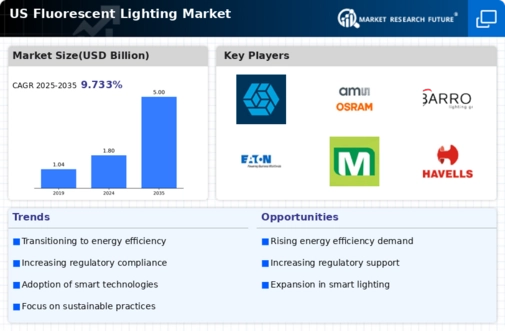Cost-Effectiveness and Long Lifespan
The cost-effectiveness and long lifespan of fluorescent lighting are significant drivers in the market. Fluorescent lights typically last 7 to 15 times longer than incandescent bulbs, which translates to lower replacement costs and reduced maintenance efforts. Additionally, the initial investment in fluorescent lighting is often offset by the savings on energy bills, as these lights consume less electricity. This economic advantage is particularly appealing to both residential and commercial users, who are increasingly looking for ways to optimize their lighting expenditures. As the fluorescent lighting market continues to emphasize these financial benefits, it is likely to attract a wider customer base seeking reliable and economical lighting solutions.
Growing Demand in Commercial Sectors
The fluorescent lighting market is experiencing a surge in demand from commercial sectors, particularly in retail, offices, and educational institutions. These sectors are increasingly opting for fluorescent lighting due to its cost-effectiveness and longevity. According to recent data, commercial buildings account for approximately 40% of total energy consumption in the US, prompting businesses to seek energy-efficient lighting solutions. Fluorescent lights, known for their lower operational costs and extended lifespan compared to traditional incandescent bulbs, are becoming the preferred choice. This trend is likely to continue as businesses aim to reduce energy expenses and enhance their sustainability profiles, thereby driving growth in the fluorescent lighting market.
Technological Advancements in Lighting
Technological advancements play a crucial role in shaping the fluorescent lighting market. Innovations in fluorescent lamp design, such as improved phosphor coatings and electronic ballasts, have enhanced the efficiency and performance of these lighting solutions. The introduction of compact fluorescent lamps (CFLs) has also contributed to the market's growth, offering consumers a more versatile and energy-efficient option. Furthermore, advancements in manufacturing processes have led to reduced production costs, making fluorescent lighting more accessible to a broader audience. As technology continues to evolve, the fluorescent lighting market is likely to benefit from ongoing improvements in product quality and energy efficiency, positioning it favorably against alternative lighting technologies.
Regulatory Support for Energy Standards
The fluorescent lighting market benefits from stringent energy efficiency regulations imposed by government bodies in the US. These regulations encourage the adoption of energy-efficient lighting solutions, including fluorescent technologies. For instance, the Department of Energy has set forth standards that require lighting products to meet specific energy consumption criteria. This regulatory framework not only promotes environmental sustainability but also drives manufacturers to innovate and improve their product offerings. As a result, the market is witnessing a shift towards more efficient fluorescent lighting solutions, which are expected to capture a larger share of the overall lighting market. The emphasis on compliance with these regulations is likely to enhance the competitive landscape within the fluorescent lighting market.
Increased Awareness of Environmental Impact
There is a growing awareness among consumers and businesses regarding the environmental impact of lighting choices, which is positively influencing the fluorescent lighting market. As sustainability becomes a priority, many organizations are actively seeking to reduce their carbon footprint. Fluorescent lighting, with its lower energy consumption and reduced greenhouse gas emissions compared to traditional lighting options, is increasingly viewed as a responsible choice. This shift in consumer behavior is prompting manufacturers to highlight the environmental benefits of fluorescent lighting in their marketing strategies. Consequently, the market is likely to see an uptick in demand as environmentally conscious consumers and businesses opt for fluorescent solutions to align with their sustainability goals.























Leave a Comment